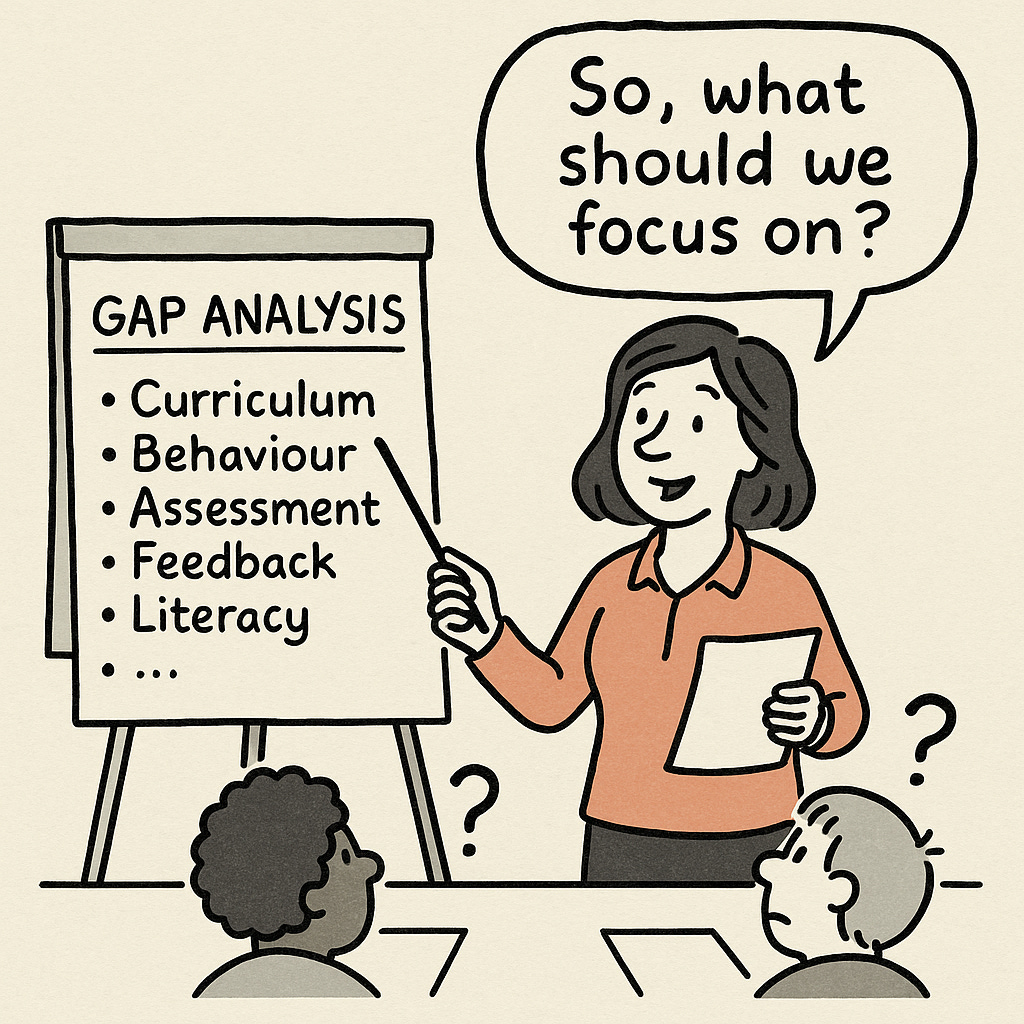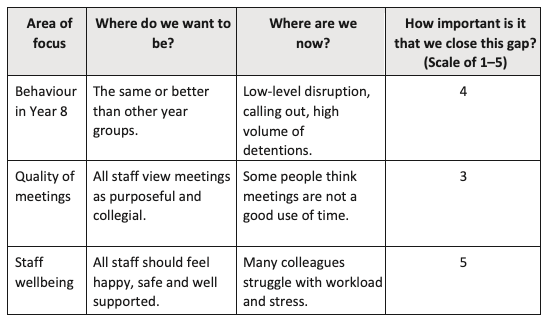Making school improvement manageable
When everything feels urgent, how do you choose what matters most?
School improvement is messy and complex. There are always competing demands, limited capacity, and more good ideas than it’s possible to implement at once. Choosing where to focus is one of the most important – and difficult – decisions school leaders face.
In this first in a series of three posts, we’ll explore some practical ways to navigate that complexity – starting with a 'gap analysis'.
Let’s dive in!
Step 1: Analyse gaps
There are many ways to do a gap analysis, some more in-depth than others. In this post, we’ll do a quick version. This is not about analysing attainment gaps between different demographic groups, although it can involve that. Rather, it’s about throwing the net wide and looking at the difference between where you are and where you want to be in different areas of school life.
To get started, create a long-list of areas where you feel improvements could be made. This is likely to feature the things on your school improvement plan, but throw the net a little wider - aim for around 5–7 at this stage. Here are some examples – feel free to add, change or delete items as you see fit.
Quality of teaching
Consistency of teaching
Progress
Attainment
Curriculum
Learner effectiveness
Behaviour and relationships
The attainment gap
Assessment
Feedback
Pupil wellbeing
Staff wellbeing
Use of data
Professional learning
Pastoral support
Attendance
Meetings and email culture
Coaching
Performance management
Parental engagement
For each of the items on your long-list, ask three questions:
Where do we want to be? (Sum up in a phrase or sentence.)
Where are we now? (Sum up in a phrase or sentence.)
On a scale of 1–5, how important is it that we close this gap? (1 is ‘not at all important’ and 5 is ‘this cannot wait’.)
If you’re doing this as a team, it’s a good idea to do this exercise individually at first before comparing notes and creating a shared version. Don’t overthink it – just jot down whatever comes to mind as you ask these questions. To keep your responses succinct, refer to the worked example below:
Step 2: Identify potential improvement strategies
For each gap you analysed in Step 1, identify potential strategies that could take you from where you are to where you want to be. The aim here is to get a sense of how easy or difficult it might be to close any gaps you've identified. Keep it ‘broad strokes’ for now – we’ll explore how to design an improvement strategy in granular detail in a future post.
To continue with our examples, potential improvement strategies might include:
To improve behaviour in Year 8, we could:
Conduct observations to understand current behaviour patterns.
Train teachers in preventive rather than reactive strategies.
Simplify school rules.
Establish peer mentoring.
Re-establish expectations with Year 8.
Build relationships with key parents and carers.
Change the lunchtime duty rota.
Increase senior staff visibility during lesson changes.
Create a centralised detention system focused on restorative conversations.
To create more purposeful meetings, we could:
Convene a teacher focus group to explore perceptions.
Create a meetings task force.
Train leaders in effective meeting management.
Set aside collaborative planning time for middle leaders.
Abolish scheduled meetings in favour of need-based meetings.
To improve staff wellbeing, we could:
Run a staff survey on wellbeing and workload.
Set up a wellbeing committee.
Implement workload reduction plans.
Provide optional weekly wellbeing activities.
Once you’ve analysed gaps and identified potential improvement strategies, the next step is to figure out which one to tackle first – because you can’t do it all, as much as you might like to.
In the next post, we’ll explore a simple but effective way to prioritise your focus and set yourself up for success.
In the meantime, I’d love to hear how you approach this in your setting. How do you find your focus when everything feels urgent? Are there any questions, tools or ways of working that you’ve found useful?
Feel free to share your ideas and experiences in the comments. I’d love to hear your thoughts!
James







I really like your approach. You bring a wonderful challenge to why lots of effort doesn't result in meaningful change. Your book and models are really helpful.
I wonder with this post if there is a step between gap and strategy in t
Identifying the underlying needs of the gap.
Based on starting new schools though I think there is a need for a different process, especially if you are trying to do something different. A consideration of our starting conditions, necessary scaffolds when a new curriculum, pedagogy and assessment system are happening in a new space with a new team. The rate of scaling is another critical factor. I’d love someone to research the school we are opening in September. If you know of people who might be interested please let me know.